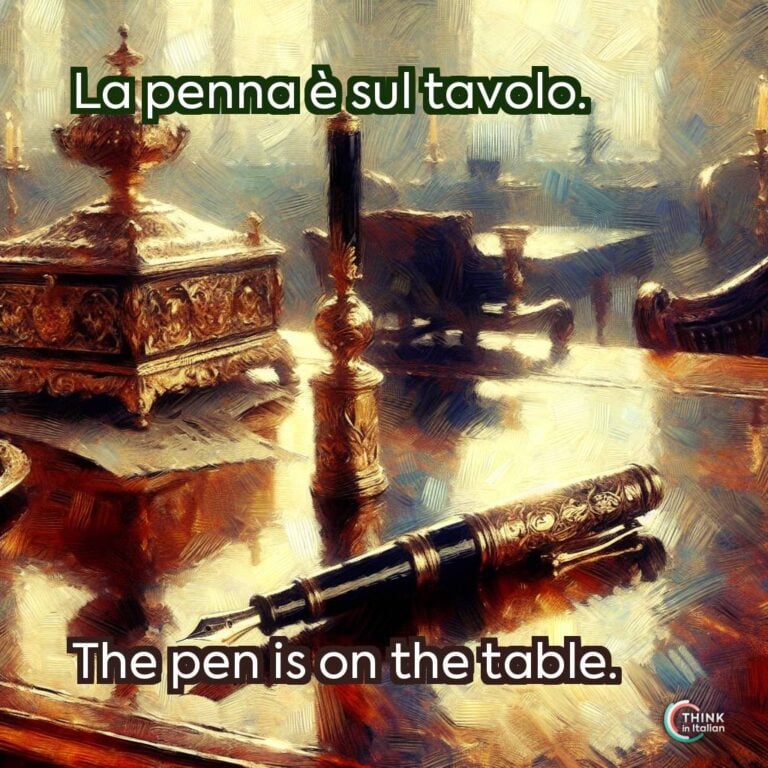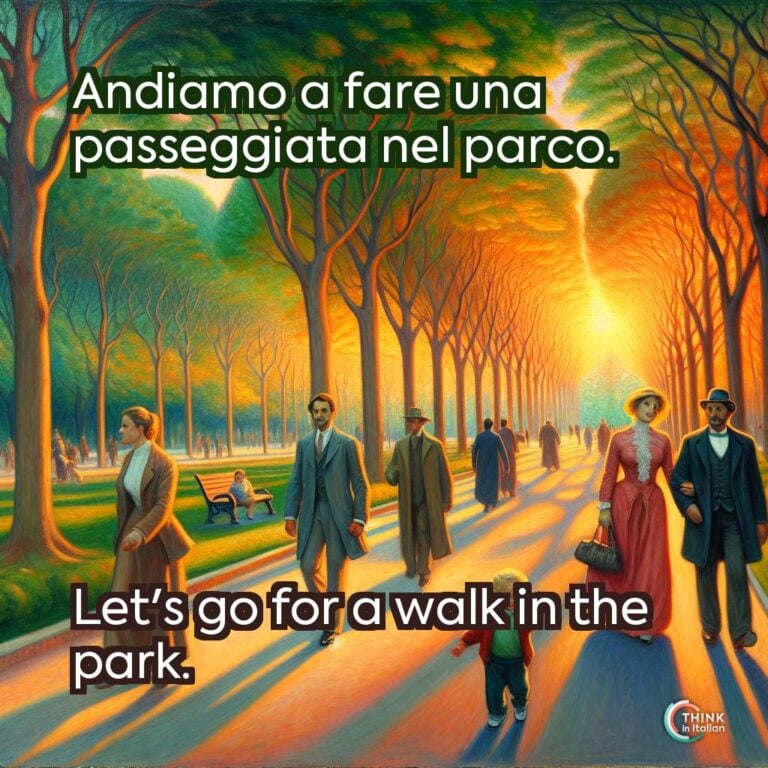Italian Prepositions
What are Prepositions
Let’s start from the basics: prepositions are words that show the relationship between a noun (or pronoun) and other elements in a sentence. They often indicate direction, location, time, or manner.
Italian prepositions are called preposizioni semplici (simple prepositions). They are called this way when they stand alone, without combining with anything else.
If they combine with a definite article, then they are called preposizioni articolate (articulated prepositions), and I will show them below.
Notice: whenever a preposition can combine with a definite article, it must!
Italian Prepositions Chart
As follows, I created a table with all the Italian prepositions, their translations, and examples:
| Preposition | Translation | Example in Italian | Example in English |
|---|---|---|---|
| Di | of | Il libro di Marco. | Marco’s book (the book of Marco). |
| about | Parliamo di musica. | We talk about music. | |
| A | at | Sono a casa. | I am at home. |
| to | Andiamo a Roma. | We are going to Rome. | |
| Da | from | Vengo da Milano. | I come from Milan. |
| since | Vivo qui da maggio. | I live here since May. | |
| by | Il libro è scritto da lui. | The book is written by him. | |
| In | in | Vivo in Italia. | I live in Italy. |
| to | Andrò in ufficio. | I will go to the office. | |
| Con | with | Esco con gli amici. | I go out with friends. |
| Su | on | Il libro è sul tavolo. | The book is on the table. |
| about | Un libro su Leonardo da Vinci. | A book about Leonardo da Vinci. | |
| Per | for | Questo regalo è per te. | This gift is for you. |
| through | Passiamo per il parco. | We walk through the park. | |
| Tra/Fra | between | La scuola è tra la biblioteca e il parco. | The school is between the library and the park. |
| among | Tra tutti i partecipanti, lui è il migliore. | Among all the participants, he is the best. |
How to use Italian Prepositions
- di is used to:
- To talk about ownership
Questa borsa è di Eleonora.
This bag is Eleonora’s.
-
- To describe materials and substances
La mia maglia è di cotone.
My shirt is made of cotton.
-
- Say the origin (after the verb essere)
Io sono di Roma, e tu di dove sei?
I am from Rome; where are you from?
-
- Express time, as in parts of the day and days of the week
Mi piace leggere di sera.
I like reading at night.
Vado in ufficio di lunedì.
I go to the office on Mondays.
-
- Describe topics with verbs such as parlare (to speak/talk), discutere (to discuss), etc.
Stiamo parlando di politica.
We’re talking about politics.
Questo caffè è molto più buono di quello.
This coffee is much better than that one.
- Da is used to:
- Express origins of movement and motions
Sono partita da casa mia.
I left my place.
-
- Express movements toward a person
Oggi vado a pranzo da Michele.
Today I’m going for lunch at Michele’s.
-
- Talk about goals and aims (da + infinitive)
Ho tantissimo lavoro da finire!
I have too much work to finish!
-
- Describe when an action has started in the past
Studio italiano da 2 anni.
I’ve been studying Italian for 2 years.
-
- Describe the agent in passive sentences
Questa commedia è stata scritta da Gogol.
This comedy was written by Gogol.
- In is used to:
- Describe the movement to or state in a place (with countries and regions, with cities, we use a)
Sono in Francia.
I am in France.
Domani andiamo in Puglia.
Tomorrow we are going to Puglia.
-
- Describe means of transportation
Siete venuti in treno o in aereo?
Did you come by train or by plane?
-
- Talk about seasons
I fiori sbocciano in primavera.
Flowers bloom in spring.
-
- Describe the amount of time it takes to do something
Ho finito il libro in soli tre giorni.
I finished the book in just three days.
- A is used to:
- Talk about the movement to or state in a place
Domani vado a Milano per lavoro.
Tomorrow I am going to Milan for business.
Sono al mare in questo momento
I am at the beach right now
-
- Say the precise time
Esco dalla palestra alle sei di sera.
I leave the gym at 6 pm.
-
- Describe the recipient of an action
Devo dare 10 euro a Maria.
I need to give 10 euros to Maria.
- Su is use to:
- Describe placement or position
Il tuo quaderno è sul tavolo.
Your book is on the table.
-
- Describe the subject of a topic
Ieri ho guardato un documentario sulla storia russa.
Yesterday I watched a documentary about Russian history.
- Con is used to:
- Talk about company
Andiamo al cinema con mia cugina stasera.
Tonight we’re going to the cinema with my cousin.
-
- Describe the use of a tool
Ho fatto un succo di mora con il frullatore.
I made blackberry juice with the blender.
- Per is used to:
- Talk about reason or cause
Mi sono trasferita qui per lavoro.
I moved here for work.
-
- Express duration
Abbiamo parlato per più di 2 ore.
We talked for over 2 hours.
-
- Describe a means or a final destination
Il mio volo passa per la Danimarca.
My flight goes through Denmark.
Domani Gianluca parte per la Colombia.
Gianluca is leaving to Colombia tomorrow.
- Tra and fra are interchangeable prepositions and are used to:
- Describe something that is located between two or more things
Mi è caduto il telefono tra il divano e la credenza.
My phone fell between the sofa and the dresser.
-
- Indicate in how long something will happen in the future
Il concerto è tra una settimana.
The concert is in one week’s time.
-
- Differentiate between options
Tra i due preferisco questo.
I prefer this between the two.
Italian Prepositions With Articles
As I mentioned before, anytime a simple preposition can be combined with an article, it must. However, not all of them create a new form when combined.
Only di, a, da, in and su can become articulated prepositions (preposizioni articolate). To do this, you simply join the preposition with the definite article you need, in order to create a new unique word, as you can see below:
| il | lo | la | l’ | i | gli | le | |
| di | del | dello | della | dell’ | dei | degli | delle |
| a | al | allo | alla | all’ | ai | agli | alle |
| da | dal | dallo | dalla | dall’ | dai | dagli | dalle |
| in | nel | nello | nella | nell’ | nei | negli | nelle |
| su | sul | sullo | sulla | sull’ | sui | sugli | sulle |
Prepositional Verbs
Just like English, some Italian verbs require specific prepositions to convey their correct meaning. These verbs are called prepositional verb and can be particularly challenging for learners because they do not always have direct equivalents in English. Here are some examples:
- Pensare a (to think about):
Penso a te ogni giorno.
I think about you every day.
- Pensare di (to have an opinion about or to consider doing something):
Penso di andare in vacanza.
I am thinking of going on vacation.
- Dipendere da (to depend on):
Dipende dal tempo.
It depends on the weather.
-
Partecipare a (to participate in):
Partecipo a un concorso.
I participate in a contest.
-
Temere di (to be afraid of):
Temo di sbagliare.
I am afraid of making a mistake.
-
Fidarsi di (to trust):
Mi fido di lui.
I trust him.
- Finire / Smettere di (to finish/stop doing something):
Ho finito di leggere il libro.
I finished reading the book.
- Iniziare / Cominciare a (to begin to):
Ho cominciato a studiare italiano.
I began to study Italian.
Master Italian Prepositions
Learning how to use Italian prepositions is crucial for mastering the language. They are small words but their use is essential: they clarify relationships between words and add precision to communication.
They are key to forming accurate sentences and their proper use enhances fluency, making conversations smoother and more natural.
Practice the use of the Italian preposition in different contexts and get ready to speak like a native!




